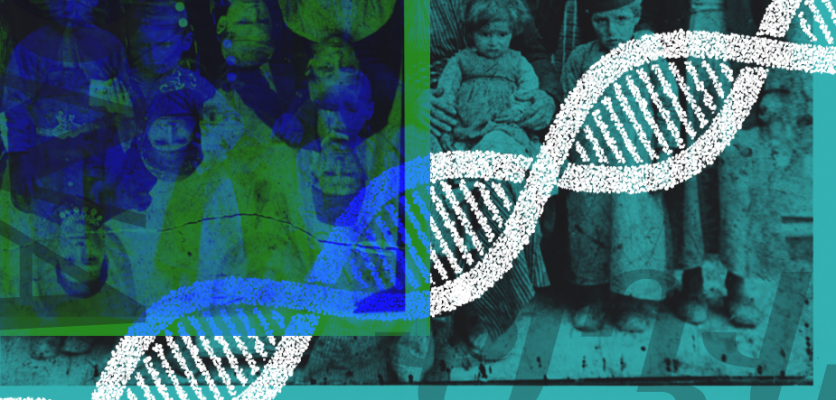Putting DNA to the test: An Armenian perspective on genetics and identity
April 25, 2020
AncestryDNA, 23andme, LivingDNA: Just a few years ago, outside of the genetics community, these terms would have drawn blank stares. Yet, today, it seems like these DNA testing kits are everywhere, from drug stores and cheesy commercials to skits on late-night comedy talk show routines. And while there are many benefits of “discovering” one’s DNA, there is also a dark side that needs reckoning. Through the example of Western Armenia’s “hidden Armenians,” we see both perspectives of this debate.
Identity in a vial
Genetic (or DNA) testing has been around for decades, but only now has it become such a wildly lucrative business in the United States, with no signs of slowing down. In a short period of time, testing companies have become a part of our daily lexicon, changing the discussion around identity, genetics, and family history. It’s not all that surprising why so many Americans are fascinated by them.
In a nation that was built on the premise of a “melting pot,” these kits offer to parse out each cultural “ingredient,” one by one, to give Americans a sense of identity beyond what they’ve ever known. The consumer’s role is as easy as possible—requiring just a simple swab inside the cheek; the lab takes care of the rest. It’s hard to deny the allure and convenience of these ubiquitous tests.
But with those benefits come the ever-increasing warning labels about all of the nefarious ways in which these testing companies, quite literally, use your DNA against you. I was torn about using this approach to “prove” or “discover” my Armenianness.
.png) "My family is from Mazira" (Digital art: h-pem)
"My family is from Mazira" (Digital art: h-pem)
Armenian in blood
Two summers ago, in my uncle’s kitchen in Yerevan, I convinced my Papik (grandfather) to hold off on his breakfast to indulge me and 23andme. I told him that this might help us find family from all over the world—in Sasun, even. While my younger relatives remained skeptical about why I was asking a 90-year-old man to remember the past in more ways than one, Papik was delighted to help in any way he could. At one point, he even offered to have his blood drawn. (And was perhaps a little too entertained to hear about the uncomfortable troubles that would pose for me at airport security.)
Even though Papik’s test results came back exactly as I had predicted, I struggled to determine what that meant for me. A few months later, my Tatik (grandmother)—from the other side of the family tree—moved in with us. I set off on a personal quest to uncover everything about our family’s past, starting with purchasing another DNA kit.
While I was confident that there would be no surprises with Papik, this time, I wasn’t so sure. Doubt and uncertainty crept in. Maybe I am not “100 percent Armenian,” after all. But so what? Would that “fact” really change anything? Should it?
Tatik passed away last year. The kit now sits in my closet, like an old photograph, collecting dust.
It is fascinating how many Armenians use the blood barometer for measuring Armenianness—especially in the diaspora—when, in the United States, for example, there is only one minority group that is required to prove a blood quantum, in order to gain status as a member of that community: Native Americans. Many argue that this policy has succeeded in dividing natives over who is “more native” than the other. (Sound familiar?)
In 2018, a very high-profile politician attempted to “prove” her native ancestry through DNA testing, which provoked outrage from many in the Native American community. Shortly thereafter, a Cherokee Nation tribal chief explained that one cannot prove or assert their native status through a blood quantum, and doing so “makes a mockery of DNA tests” and “dishonors” tribes.
We Armenians—especially in the diaspora, where maintaining an Armenian identity has been a struggle—have engaged in similarly unfortunate tactics. I didn’t realize how much I had internalized this way of thinking.
Armenian in soul
In the summer of 2017, I joined nine other Armenian-Americans on a journey to Western Armenia (in modern-day Turkey), where simply stating that you are Armenian is effectively putting a target on your back. Remarkably, many of the “hidden Armenians” we encountered trusted us, complete strangers, with a secret that their closest friends and neighbors—and sometimes even relatives—did not know. But how did they come to “discover” their Armenian identities?
Our first evening, we gathered with a dozen hidden Armenians in Diyarbakir. Two expressed interest in taking a DNA test. While preparing the kits, one woman—who openly professed her Armenianness and recent conversion to Christianity—adamantly refused to participate. She expressed distrust in her government’s handling of the results. Indeed, the Turkish state has been (not-so-secretly) assigning its minorities “race codes” since its founding. Her trepidation at what this information could mean for her livelihood was understandable.
But beyond the security concerns, she emphasized that she did not need a saliva test to tell her that she was one-quarter or one-eighth Armenian. She felt Armenian. She knew it in her heart, wholly and undoubtedly.
Before departing, she treated us to a beautiful rendition of the folk classic, “Sareri hovin mernem,” (“I’ll Die for the Wind of the Mountains”), which was originally an ode to one’s lover who has been lost in the mountains, but also serves as a hymn for victims of the Genocide. I recall the goosebumps on my arms as she sang this tune I grew up hearing and she had only recently learned.
Though everyone was in tears, it did not feel like a song of loss and despair. This was her power ballad, a fighting song, and a celebration of the reclamation of her identity. She had rediscovered a lost branch of the family tree, and all without the help of a single testing kit.
A blessing or a curse?
As we discovered in that little cafe in Diyarbakir, the actual percentages of Armenian or Turk, Nigerian or Polynesian, are of little importance. Reuniting families and their lost stories is the true inimitable power of these kits. Perhaps they might encourage those who have been deprived of their historical legacies to assemble a part of their family’s puzzle piece. And perhaps some may decide to learn more, engage, and even embrace that element and make it their own.
Or not. Not every person is going to accept their newfound identity, just because some scientist in an inconspicuous lab told them they are not who (or what) they think they are. And, similarly, not every person is going to suddenly ditch their lederhosen for a kilt, just because AncestryDNA tells you you’re Scottish, not German. But in a sea of fluctuating emotions, these ki(L)ts can provide some solace for a community that longs for answers.
To test or not to test? Ultimately, that’s for the user to decide.
Have you or a loved one ever taken a DNA test? Do you plan to? Let us know in the comments!
Also, be sure to check out this riveting talk on genealogy and identity in Western Armenia by genealogist George Aghjayan!
Join our community and receive regular updates!
Join now!


Lydia Gaeta
26 Apr, 2020 05:21:50 Edited
I did the Ancestry test and had both my parents do it. When I first did it about 3 years ago my mothers side came back 99.9% as expected. Ancestry is constantly updating info and so our dna results get ‘fine tuned’ periodically and it’s changed a little. Nothing major, but there is a small % of Italian in there now. It’s very interesting. I’ve also discovered that my Armenian matches aren’t very interested in connecting! That surprised me.
1
Reply